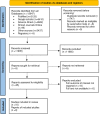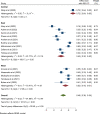Prevalence and predictors of COVID-19 vaccination hesitancy among healthcare workers in Sub-Saharan Africa: A systematic review and meta-analysis
- PMID: 37506132
- PMCID: PMC10381063
- DOI: 10.1371/journal.pone.0289295
Prevalence and predictors of COVID-19 vaccination hesitancy among healthcare workers in Sub-Saharan Africa: A systematic review and meta-analysis
Abstract
Background: The COVID-19 vaccination is regarded as an effective intervention for controlling the pandemic. However, COVID-19 vaccine hesitancy is hampering efforts geared towards reducing the burden of the pandemic. Therefore, examining COVID-19 hesitancy and its predictors among healthcare workers is essential to improving COVID-19 uptake. In sub-Saharan Africa, the pooled proportion of COVID-19 vaccine hesitancy is yet to be known.
Purpose: The present study was to estimate the pooled proportion of COVID-19 vaccine hesitancy and its predictors among healthcare workers in Sub-Saharan Africa.
Methods: A systematic search of articles was conducted in PubMed, Science Direct, African Journal Online, and Google Scholar. Data was extracted with the help of Excel. Data analysis was conducted using STATA 17. Heterogeneity in the studies was assessed using Cochrane Q and 12 tests. A random effects model was used to examine the pooled estimates to determine if heterogeneity was exhibited.
Results: A total of 15 studies involving 7498 participants were included in the final analysis. The pooled prevalence of COVID-19 vaccination hesitancy among healthcare workers was 46%, 95% CI (0.38-0.54). The predictors of COVID-19 hesitancy were negative beliefs towards vaccine 14.0% (OR = 1.05, 95% CI: 1.04, 1.06), perceived low risk of COVID-19 infection 24.0% (OR = 1.25, 95% CI: 1.23, 1.28), and vaccine side effects 25.0% (OR = 1.23, 95% CI: 1.21, 1.24).
Conclusion: The data revealed generally high hesitancy of COVID-19 vaccine among health workers in Sub-Saharan Africa. Future COVID-19 adoption and uptake should be improved by national and individual level efforts. In Sub-Saharan Africa, it is crucial to address the myths and obstacles preventing healthcare professionals from accepting the COVID-19 vaccination as soon as feasible since their willingness to get the vaccine serves as an important example for the broader public.
Copyright: © 2023 Kigongo et al. This is an open access article distributed under the terms of the Creative Commons Attribution License, which permits unrestricted use, distribution, and reproduction in any medium, provided the original author and source are credited.
Conflict of interest statement
The authors have declared that no competing interests exist.
Figures




References
-
- Iwu C. A., Ositadinma P., Chibiko V., Madubueze U., Uwakwe K., and Oluoha U., “Prevalence and Predictors of COVID-19 Vaccine Hesitancy among Health Care Workers in Tertiary Health Care Institutions in a Developing Country: A Cross-Sectional Analytical Study,” Advances in Public Health, vol. 2022, 2022.
Publication types
MeSH terms
Substances
LinkOut - more resources
Full Text Sources
Medical

